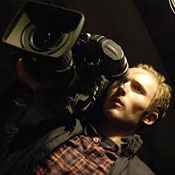- REVIEW
- READER REVIEWS
Diary of the Dead
|
(No longer in theaters)
|
|
Genre
Horror, Suspense/Thriller
Producer
Steve Barnett
Distributor
The Weinstein Company
Release Date
Feb 15, 2008
Release Notes
Limited
Official Website
Review
Compared with other first-person motion-sickness horror pictures like The Blair Witch Project and Cloverfield, George A. Romero’s Diary of the Dead is weak tea, yet there’s enough social commentary (and innovative splatter) to acidulate the brew�to remind you that Romero, even behind the curve, makes other genre filmmakers look like fraidy-cats. This is not a continuation of the living-dead saga that began with the 1968 masterpiece Night of the Living Dead. It’s set in the age of the Internet, from which the grim narrator, Debra (Michelle Morgan), downloads unedited footage of a TV correspondent getting chomped by a supposedly dead crime-scene victim. The movie is a video within a video within a video: Diary of the Dead is supposed to be Debra’s cut of her boyfriend Jason’s cut of The Death of Death, a first-person documentary of the reanimation of the dead that interrupted the shooting of Jason’s low-budget horror movie about the reanimation of a mummy. Got that? Reality is mega-mediated.
Debra explains that she’s finishing The Death of Death to reveal the truth that the government and its lackey mainstream media have suppressed�although it’s unclear how the population could remain oblivious to marauding zombie cannibals. Is this a metaphor for the atrocities happening oceans away, in Iraq? Can’t rule it out. Night of the Living Dead was the American cinema’s most visceral distillation of the social and racial upheavals of the sixties: Authority had collapsed, rifle-toting rednecks roamed the countryside, members of the nuclear family were slurping one another’s intestines. Romero carries on his critique in Diary. The National Guard doesn’t save the student protagonists but robs them of food and supplies. The wealthy barricade themselves in their mansions. African-Americans armed to the teeth confess there’s something exciting about having power after the rich white folks have fled.
But the odyssey of Debra, Jason (Josh Close), an alcoholic film professor (Scott Wentworth), and sundry nubile coeds is not especially enlivening. (Their destination? Where else in a Romero picture? Pittsburgh.) Like the memoir in which the first-person singular appears 23 times on every page, the �diary� film is getting old fast, and its limited vantage is especially frustrating here. Romero doesn’t have the speed-freak metabolism of the makers of Blair Witch and Cloverfield. His gift is for montage�for long shots of loping flesh-eaters mixed with low-angle close-ups of mottled faces, the remote side by side with the invasive. When Jason cuts together some zombie-attack footage on a computer, Diary of the Dead suddenly bestirs itself. That’s what the movie needs: editing!
It should be said that Romero’s lack of oomph is not just a sign of his age. It’s also a matter of conviction. Cloverfield was all You Are There sensation and no context�lovelorn yuppies amid the kind of devastation that rekindled the terrors of 9/11 to no good end. Romero can’t make a first-person movie without indicting his own techniques. Jason isn’t only documenting reality; he orders his friends to reenter a door to get more coverage. Later, he realizes that the camera has inoculated him from the true horror�that he’s seeing the world through a lens darkly. But that knowledge doesn’t help. When he’s infected, on the verge of becoming a zombie-cannibal, he asks Debra to shoot him�but with a camera, not a bullet.
Social, shmocial, you’re probably saying: How’s the grue? Juicy. In his half of Grindhouse, �Planet Terror,� Robert Rodriguez served up greater quantities of zombie carnage, but Romero wins the quality contest. And it’s not just that heads split open at geometrically intriguing angles, it’s that the ghouls aren’t mere cannon fodder. One poor fellow in the African-American compound gets acid dumped on his head, which dissolves oh-so-slowly as he staggers around in melancholy incomprehension. Diary of the Dead ends with a bit of editorializing as the upper half of a zombie head sways in the breeze, its eyes still seeing. It’s abrupt and crude (this is a Weinstein release, so there might have been carnage in the editing room), but it’s on message. Romero thinks we’ve lost the capacity to see. The movie suggests that uploading the truth won’t help us see it any clearer.
Related Stories
New York Magazine Reviews
- David Edelstein's Full Review (2/18/08)
